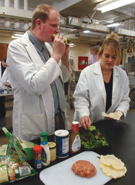| |
 |
UF
Researchers Create Low–Carb Tortilla
|
downloadable
pdf
 |
| Food
biochemist Hordur Kristinsson, left, and recent UF graduate
Lauren O’Kelley prepare and taste low-carbohydrate,
high-protein tortillas a team of students led by Kristinsson
created out of chicken protein. |
A
new low-carbohydrate, high-protein food product created by
University of Florida researchers could give dieters a new
weapon in the battle against obesity.
It’s the “flaquita,” an all-meat tortilla
that promises to squeeze the last few carbohydrates out of
the low-carb wraps now offered at many restaurants.
“I think we came up with this at just the right time,”
said Michael Madden, a recent graduate in food science and
human nutrition from UF’s Institute of Food and Agricultural
Sciences. “With so many people on the Atkins and South
Beach diets, there’s a big demand for low-carb wraps
right now.”
Made of protein extracted from chicken, the flaquita isn’t
just a piece of meat to wrap around lettuce, tomatoes and
other sandwich fixings. It looks and feels much like a flour-based
tortilla, but with only a fraction of the carbohydrates found
in most tortillas. A single flaquita contains only 2.6 grams
of carbohydrates compared to about 11 grams for a corn tortilla
or 22 grams for a flour tortilla, the flaquita’s inventors
say.
The name of the new tortilla is derived from the Spanish word
“flaco,” which means “thin,” although
they point out that the flaquita isn’t limited to use
in Latin foods.
Madden and two other recent graduates of UF’s food science
and human nutrition program, Meghan Meller and Lauren O’Kelley,
came up with the idea while studying under Hordur Kristinsson,
an assistant professor of food biochemistry at UF who specializes
in problems related to the seafood industry.
In the late 1990s, Kristinsson and researchers at the University
of Massachusetts Amherst began looking for ways to salvage
the parts left over when fish are filleted in processing plants.
Those leftovers — fins and bones with meat still attached
— are sometimes sold for use in cat food, animal feed
or fertilizer. But because they fetch such a low price, Kristinsson
says, the leftovers often wind up in landfills or are dumped
at sea.
“The original work on this technology was inspired by
environmental concerns,” Kristinsson said. “We
wanted to turn this material into something that had a lot
more value, to find a use for things that otherwise might
be thrown away.”
Kristinsson and his colleagues found that by grinding up the
fish parts, suspending them in a basic solution and spinning
them in a centrifuge, they could separate protein from the
other compounds in the fish.
It may not sound like a pretty process, but the end result
is a mild-tasting, bland-looking white paste composed almost
entirely of pure protein. Because it can be mixed with other
substances and easily picks up their flavor, Kristinsson says
the protein can be used in a wide variety of products, such
as imitation crab meat or artificial scallops, or injected
into fish fillets to improve their flavor and texture.
Kritinsson and his colleagues found that the process produced
similar results in chicken and other kinds of meat, creating
a paste of almost-pure protein from fatty scraps that would
otherwise be discarded.
Kristinsson’s students wanted to take his research a
step further and aimed to create a consumer product designed
specifically to put the extracted protein to use.
Taking a cue from the growing low-carb diet craze, the students
decided to use the protein in a product normally made of carbohydrate-rich
food. The end result is a nearly carb-free sandwich wrap that
looks and acts like a flour tortilla, but tastes ever so slightly
like chicken.
“I think flaquitas have a great prospect as a commercial
product since they are processed from proteins that are extracted
from very inexpensive secondary raw material from poultry
processing,” Kirstinsson said. “We are creating
a unique high-value product from low-value raw materials using
this novel technique that could greatly benefit the poultry,
fish and meat industry.”
Michael Madden mmpta2@juno.com
by Tim Lockette
|

